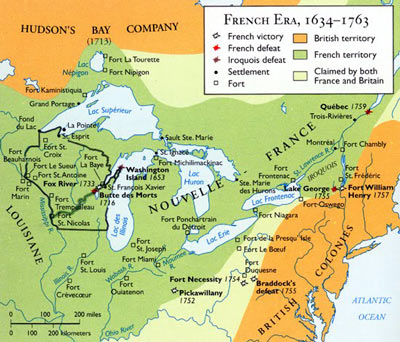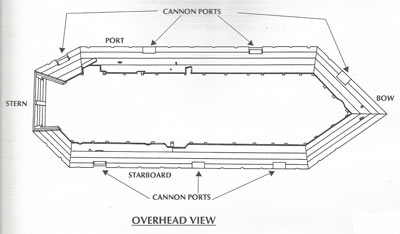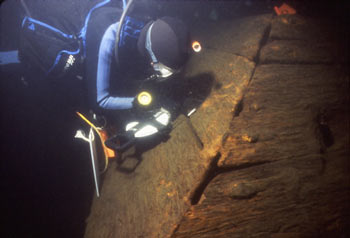Radeau Below: Lake George Holds Oldest Warship

Indians were excellent fighters along the mountain ranges and river basins. Credit: National Archives
Long and narrow Lake George, known as the Queen of American Lakes, sits at the base of the Adirondack Mountains within the upper region of the Great Appalachian Valley. It drains northward into Lake Champlain and the St. Lawrence River basin. Although Quebec and the Ohio River Valley were primary battlegrounds, so were Lakes Champlain, George and other waterways. It’s said that soldiers preferred the many battles on the water to trudging through roadless mountainous terrain.

Map shows French and English colonies and Lake George’s strategic location in the war. Credit: Lake George Tourism
The British and their colonial and Indian comrades lost a big battle in 1758 when they attacked Fort Carillon (later named Fort Ticonderoga) on Lake Champlain near the northern section of Lake George. In the battle, 4,000 French troops repelled 10,000 foes to maintain control over the Great Appalachian Valley. The British returned the following year and captured the under-manned fort, which allowed access to both Canada and the Hudson River Valley. This fort saw more action during the French and Indian War than any others. Thus Lakes George and Champlain became the strategic watery battleground for hundreds of bateaux and radeaux.

A British soldier is wounded in a battle on the Lake George shoreline. Credit: Lake George Tourism
In the winter of 1758, the English ships were intentionally sunk in shallow water in order to protect them from the enemy for the 1759 campaign. Most of the fleet was raised in the spring of 1759, except for the Land Tortoise which was never found nor mentioned in any war records. In 1990, the more than 200 year old mystery unraveled when archaeologists, using side scan sonar, discovered the wreck one and a half miles from shore in 105 feet of water. It’s believed the vessel slid, perhaps during a storm, from the shallows to the deep part of the lake.

Drawing of the 52-foot-long and 18-foot-wide radeau gunboat. Credit: M-Z Information

Marine archaeologist Joe Zarzynski takes measurements on the sunken radeau. Credit: Lake George
Note: Two excellent books on the subject are: Lake George Shipwrecks & Sunken History by Joseph Zarzynski and Bob Benway; Diving the “Land Tortoise” Radeau, Lake George, New York—America’s Oldest Intact Warship.
Author: Ellsworth Boyd
Ellsworth Boyd, Professor Emeritus, College of Education, Towson University, Towson, Maryland, pursues an avocation of diving and writing. He has published articles and photo’s in every major dive magazine in the US., Canada, and half a dozen foreign countries. An authority on shipwrecks, Ellsworth has received thousands of letters and e-mails from divers throughout the world who responded to his Wreck Facts column in Sport Diver Magazine. When he’s not writing, or diving, Ellsworth appears as a featured speaker at maritime symposiums in Los Angeles, Houston, Chicago, Ft. Lauderdale, New York and Philadelphia. “Romance & Mystery: Sunken Treasures of the Lost Galleons,” is one of his most popular talks. A pioneer in the sport, Ellsworth was inducted into the International Legends of Diving in 2013.
4 Comments
Submit a Comment
All Rights Reserved © | National Underwater and Marine Agency
All Rights Reserved © | National Underwater and Marine Agency
Web Design by Floyd Dog Design
Web Design by Floyd Dog Design

Thanks for this article featuring a segment of the French and Indian War. You brought back many memories from my childhood when this component of American history still received some attention. I still have a copy of Cooper’s The Last of the Mohicans which, if nothing else, at least captures the flavor of the times. You once again have delivered an important facet of nautical history that is too often overlooked.
Thanks very much. I’m glad you liked this piece. I enjoyed writing and researching it. I think it’s too bad that the French and Indian War receives so little attention anymore. As I mentioned in my article, we might be speaking French if the British hadn’t achieved victory. I’m eager to see if divers continue to discover more radeaux and/or bateaux in Lake George.
My conservation project at ECU was sugar curing a gunport lid from the Land Tortoise.
I’m’ not sure what you mean. Explain it a little bit more please.